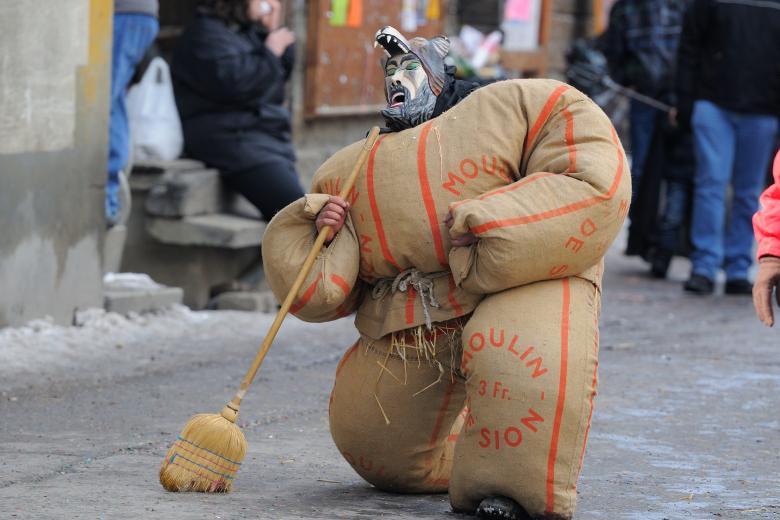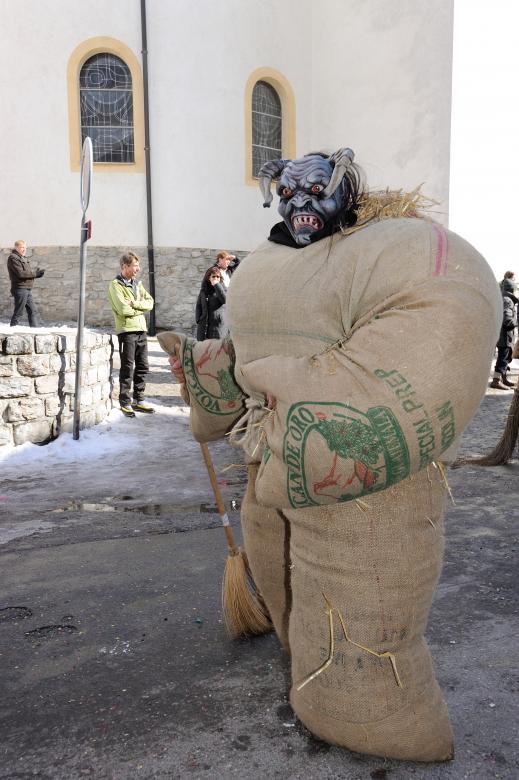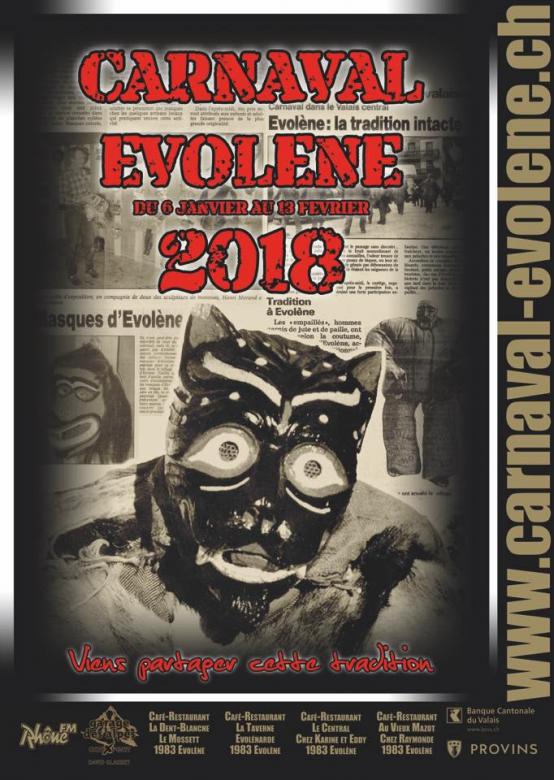Traditions that shape identities
In Evolène, a village in the Val d’Hérens (Herens Valley), there are no apologies for traditions: they are lived to the full. No one questions the tradition of carnival as it continues to pass from one generation to the next, as it always has.
In the rural areas of Switzerland customs are very important. Valais is one of those cantons that lives in harmony with its history. In the Val d’Hérens, the beginning of the year is synonymous with a festival to celebrate carnival that lasts several weeks. The people of Evolène live for their traditions. And here, traditions are not just customs, they are part of the people’s identity.
In Evolène, the strength of local traditions is a mystery. Nevertheless, the people accept them unquestioningly. They are diehards when it comes to their attachment to their roots. Speaking their local dialect, raising their own breed of Hérens cattle, or celebrating carnival comes naturally, like a cyclical movement. Irrational, unspoken, everyone is in agreement about this custom.

Another dimension
“One can’t say that Evolène wanted to maintain its patois but here you can’t speak anything else,” says Gisèle Pannatier, a dialectologist. Heart and soul a ‘Hérensarde’, she knows more about the history of her village than anyone. “We speak French on official occasions but patois amongst ourselves.” She speaks French, her mother tongue, and patois, a dialect, which she taught at university. Patois was taught for many years at school in this village in the French-speaking part of the canton of Valais, situated at an altitude of 1,300 metres. Nowadays, it is only taught in out-of-school hours. Of the 100 or more pupils at the school, 14 consecrate one hour a week to learning this ancient language. Carnival is to be seen in this dimension. It is a festive period that dates back to time immemorial, starting every year with Epiphany and ending on Shrove Tuesday, otherwise known as mardi gras.
“Carnival has been passed down the generations as a custom and by word of mouth so we don’t know exactly how far it dates back. A school book was found in 1911 containing notes written in patois with a passage that expressed the desire of schoolteachers and the clergy to abolish carnival,” recounts Ms Pannatier, who also works for the village museum and for the tourist office as a guide. “Everyone is closely attached to this festival but it is the younger generation who want to make it live on.”

Rural identity
The Evolène carnival cannot be compared with carnival celebrated in cities. It celebrates nature, animals and the working of the land, elements that bear witness to its ancient origins. It is the only carnival in Switzerland to combine crop growers and livestock breeders. It is a celebration in harmony with the rural, mountain way of life that is still lived in the neighbouring side valleys of Valais. True to their history, the people of Hérens have been protected from tourism for a long time. Nowadays they tolerate it but they remain true to their origins. “All our traditions, including our costumes, carnival, patois and our cows are parts of a whole that make up our identity. But everything just happened this way, we do not reject civilisation, and our local way of life ensures that it keeps going,” explains Ms Pannatier. “Only the death of a resident is considered reason to call a halt to the festivities – out of respect for the family”.
Peluches and empaillés
Carnival also means getting dressed up in disguise. The figures that are created are the masters of the village for the entire carnival period. This theatrical aspect permits everyone to take on another identity. “The masked figure remains this figure for the entire period of carnival. There is also a secret aspect to it.” The rule is not to try to recognise who is behind the mask and to say nothing if the identity of the person is revealed. To ensure this anonymity however, masks may be swapped. The barriers that normally exist between villagers of different social status fall by the wayside during this time. And because the costumes are heavy and bulky, up until recently only the men wore them. Times have changed though and increasingly girls don the costumes and masks typical of Evolène. Now, the empaillés and peluches come together as one to invade the streets of the village on the last Sunday in a celebration in which all the villagers take part. The following Monday is dedicated to the girls.

Long ago, everything was allowed. It was a time of complete chaos. Chicanery and crowds pushing and shoving were the order of the day. Sowing terror and fear was used to frighten off bad spirits and bring on the end of winter. For the last thirty years or more, the carnival of Evolène has become known outside the valley and the customs have become less rustic. Tourism is tolerated but with a warning: the people of Evolène insist that they are not there to provide a show and that it is not their intention to attract crowds.
There are two forms of disguise unique to Evolène: peluches and empaillés. They represent the link that binds people to nature and their animals. The peluche is a figure in an untanned animal hide together with a mask. The empaillé is another figure wrapped in straw to represent the human figure of the cultivator; he also wears a mask. Straw and animal hides were frequently used for disguises in earlier times, but Evolène remains the only carnival which cannot and will not forego these two materials. The masks have human features. Be they an effigy of the devil, a lion, a cat or a monster, they are sculpted out of wood. They can be borrowed and lent, but the rule remains that an individual mask is owned by the craftsperson who created it in accordance with their personal criteria. The work is time-consuming, taking between one and four days of sculpting depending on what is required, but the sculptor always draws a certain pride from the result.

Mystery and seduction
Carnival also plays another role which concerns young men in particular. In the old days the liberty and daring of carnival enabled boys and girls to meet. Peluches and empaillés courted the young girls without lifting their masks. Revealing one's identity only happened once the period was over. “It was like a rite of passage for the young people, which brought its share of surprises, in harmony with our spirit of celebration,” recalls Gisèle Pannatier. Today, wearing a mask is not restricted to a single category of villager. Lots of young people and even children roam the streets behind their masks. “The festivities are lively, noise is the privilege and prestige of carnival. Church bells are rung throughout, creating an overall atmosphere of self-perpetuating movement and excitement that attracts crowds and especially children.”
A fascination that unites people
Carnival fascinates young and old alike because it attracts, is visually stimulating and the older one is, the more convincing it is. The village children are initially frightened by it, but then they get dressed up in disguise and develop a taste for it. This fascination grows bit by bit before it takes hold and spreads to others. Initially sceptical, the younger generation have embraced carnival in order to turn this custom to their own liking. And there lies the secret of its longevity. In the words of Gisèle Pannatier: “If ever carnival did not take place it would be sorely missed. We, the villagers and natives of this place see it, naturally, as a rite of passage. The proof: I've never known anyone to miss the last Sunday. Not ever”





